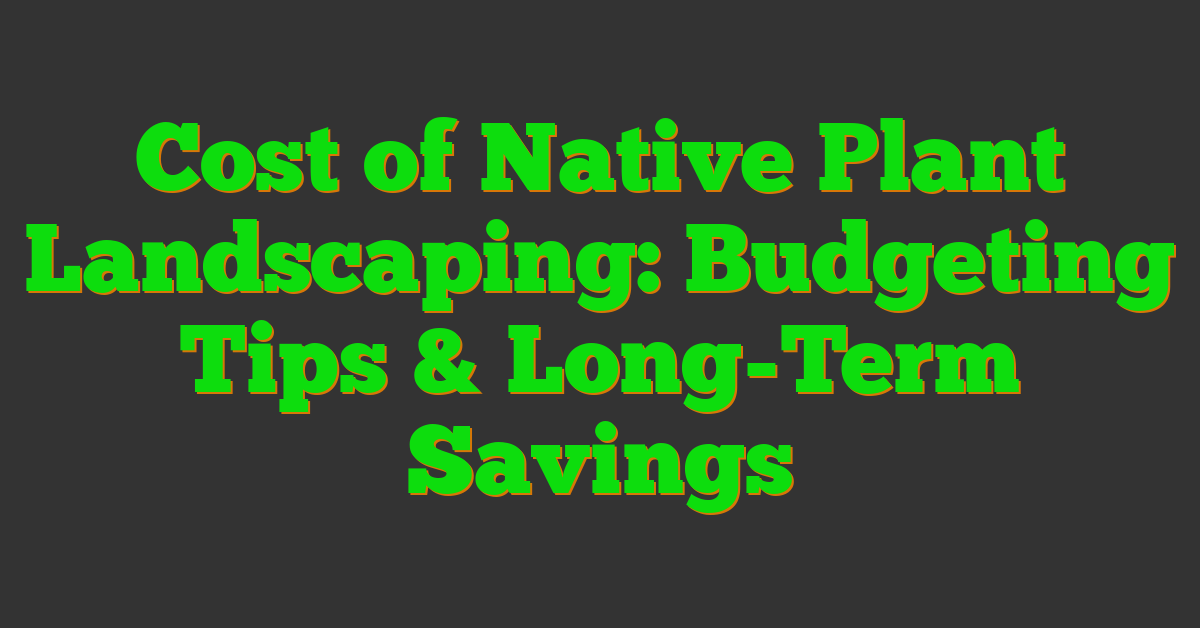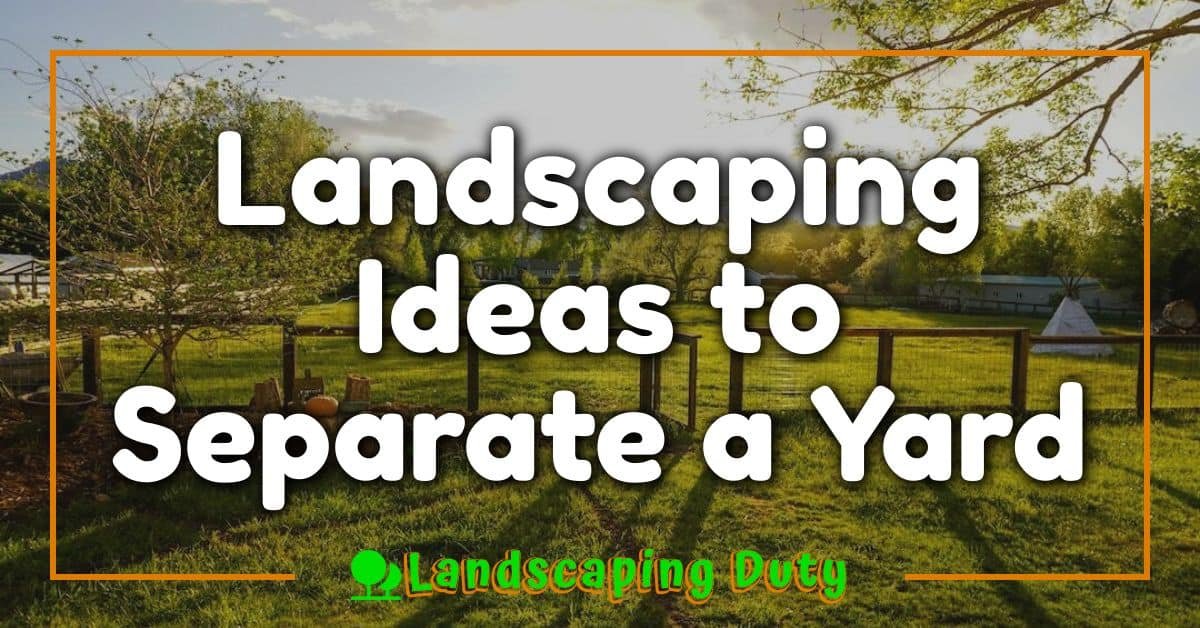I’ve always been fascinated by the beauty and resilience of native plants. Creating a garden that mirrors our local ecosystem not only looks stunning but also supports wildlife and conserves water.

But when I first considered native plant landscaping, the cost factors had me curious. Understanding the expenses involved can help you make informed choices and design a sustainable garden without breaking the bank. Let’s dive into what you can expect when budgeting for native plant landscaping and how to maximize your investment.
Benefits of Native Plant Landscaping
Choosing native plants transforms my garden into a sustainable ecosystem. Native species thrive in local soil and climate conditions, reducing the need for excessive watering and fertilizers. For example, using California poppies and manzanitas minimizes water usage during dry seasons.
Supporting local wildlife becomes effortless with native landscaping. Birds, butterflies, and beneficial insects find shelter and food in native plants like lavender and sage. This biodiversity strengthens the environment and creates a vibrant garden.
Cost-effective maintenance is another significant advantage. Native plants require fewer resources, such as pesticides and mowing, lowering overall maintenance expenses. Plants like yucca and agave are hardy and resist common pests, saving time and money.
Enhancing soil health is achievable through native plant roots. Deep-rooted species like oaks and ferns improve soil structure and prevent erosion. Healthier soil supports plant growth and reduces the need for additional amendments.
Aesthetic appeal remains high with native landscaping. These plants offer year-round beauty with seasonal blooms and varied textures. Incorporating natives like redbud trees and lupines ensures my garden remains attractive throughout the year.
By integrating native plants, I create a resilient and thriving garden that benefits both the environment and my budget.
Factors Affecting Cost
Understanding the factors that influence the cost of native plant landscaping helps me budget effectively. Each element plays a role in the overall investment required.
Plant Selection
Selecting native plants involves evaluating species variety and size. Different plants vary in price based on availability and maturity. For example:
- Small shrubs: $15–$30 each
- Medium trees: $50–$150 each
- Large trees: $200–$500 each
Choosing a mix of plant sizes can optimize both cost and garden aesthetics.
Site Preparation
Preparing the site ensures successful plant growth and impacts initial expenses. Key preparation steps include:
- Soil testing: $50–$100
- Grading and leveling: $300–$1,000
- Weed removal: $200–$500
Proper site preparation reduces long-term maintenance costs and enhances plant health.
Maintenance Requirements
Maintenance needs affect ongoing landscaping expenses. Native plants typically require less upkeep, but initial care is essential:
- Watering and mulching: $100 annually
- Pruning and shaping: $150–$300 per season
- Pest management: $50–$200 annually
Efficient maintenance practices ensure the longevity and beauty of native plant gardens while keeping costs manageable.
Cost Comparison with Traditional Landscaping
When comparing native plant landscaping to traditional methods, initial costs often differ. Traditional landscaping typically involves non-native species that may require higher maintenance and more resources.
Initial Installation Costs
- Plant Purchase: Native shrubs range from $15–$30 each, while traditional shrubs often cost $20–$50. Trees in native landscaping range from $200–$500, compared to $250–$600 for non-native varieties.
- Site Preparation: Both approaches require soil testing and grading, but traditional landscaping may need more weed control, increasing costs by approximately 10%.
Maintenance Expenses
- Watering: Native plants need less water once established, reducing irrigation costs by up to 30%.
- Fertilizers and Pesticides: Traditional gardens might require regular fertilizer applications and pest control, adding an annual cost of $100–$300. Native gardens generally need fewer inputs, saving $50–$150 each year.
- Labor: Maintenance for traditional landscapes can take 20% more time due to additional care requirements, translating to higher labor costs.
Long-Term Savings
| Expense Category | Native Landscaping | Traditional Landscaping |
|---|---|---|
| Initial Plant Costs | $15–$500 | $20–$600 |
| Site Preparation | Moderate | High |
| Annual Watering | Lower (30% less) | Higher |
| Fertilizers/Pesticides | $50–$150 | $100–$300 |
| Labor Costs | Lower (20% less) | Higher |
| Total 5-Year Cost | $X | $Y |
Choosing native plants can lead to significant savings over time. The reduced need for water, fertilizers, and labor contributes to lower ongoing expenses, making native landscaping a cost-effective alternative to traditional methods.
Environmental Impact
Native landscaping benefits the environment by enhancing biodiversity and supporting local ecosystems. Traditional landscaping often relies on imported species that may not thrive locally, leading to increased resource use and potential ecological imbalance.
Aesthetic and Functional Benefits
Native gardens offer year-round beauty with plants adapted to local climates. Traditional landscapes may require more effort to maintain their appearance, especially in regions with extreme weather conditions.
« Backyard Ideas for Entertaining: Transform Your Outdoor Space into a Fun & Stylish Retreat Tropical Garden Designs for Warm Climates: Create Your Lush Outdoor Oasis Today »
By evaluating these factors, I find that native plant landscaping not only supports sustainability but also provides long-term financial advantages compared to traditional landscaping approaches.
Budgeting Tips for Native Plant Landscaping
Select Cost-Effective Plants
Choosing native plants that thrive in your local climate can lower costs. Small shrubs typically range from $15–$30 each, while large trees cost between $200–$500. Mixing plant sizes balances initial investment and future growth.
Purchase from Local Nurseries
Buying from local nurseries reduces transportation expenses and ensures healthier plants. Local suppliers often offer competitive prices and seasonal discounts, helping you stick to your budget.
Plan Site Preparation Carefully
Efficient site preparation minimizes expenses. Conduct soil testing yourself to avoid professional fees. Use natural methods for grading and weed removal whenever possible to cut costs.
Implement a Phased Planting Approach
Spreading out plant purchases over time eases your budget. Start with essential plants and add more as funds allow. This strategy also helps manage garden growth effectively.
Utilize Long-term Savings
Native plants require less water, fertilizers, and maintenance, leading to significant long-term savings. Investing in native landscaping upfront reduces ongoing costs associated with traditional gardening practices.
Table: Example Plant Costs
| Plant Type | Size | Cost Range (USD) |
|---|---|---|
| Small Shrubs | Each | $15 – $30 |
| Large Trees | Each | $200 – $500 |
| Groundcovers | Per Square Foot | $2 – $5 |
| Perennials | Each | $10 – $25 |
Utilize Mulching and Composting
Applying mulch and compost improves soil health without extra costs. These materials help retain moisture and reduce the need for frequent watering and fertilizing.
Take Advantage of Rebates and Incentives
Explore local government rebates and incentives for native landscaping. These programs can offset initial costs and provide financial support for sustainable gardening projects.
Optimize Plant Placement
Strategically placing plants based on their sunlight and water needs reduces resource usage. Proper placement ensures each plant thrives with minimal intervention, keeping maintenance costs low.
Reuse and Recycle Materials
Using recycled materials for garden beds and pathways cuts down expenses. Repurposed items like old bricks or pallets add character to your garden while staying within budget.
Monitor and Adjust Your Budget
Regularly review your landscaping budget to track expenses and make necessary adjustments. Staying proactive ensures you remain within financial limits and achieve your garden goals.
Choosing the Right Native Plants
Selecting the right native plants ensures a thriving, low-maintenance garden. I evaluate climate compatibility and soil conditions to find species that flourish locally. For example, small shrubs like Artemisia cost $20 each, while larger trees such as Quercus range from $250 each. Local nurseries offer diverse options, reducing transportation costs and supporting the community.
I prioritize drought-tolerant varieties to minimize watering needs. Plant diversity enhances biodiversity and attracts wildlife; species like native wildflowers, grasses, and shrubs work well together. Additionally, I consider the mature size of plants to prevent overcrowding and ensure proper growth space. Grouping plants with similar water and sunlight requirements simplifies maintenance and optimizes resource use.
Here is a table of common native plants and their costs:
| Plant Type | Example Species | Cost Range |
|---|---|---|
| Shrubs | Artemisia | $15 – $30 |
| Trees | Quercus | $200 – $500 |
| Wildflowers | Echinacea | $10 – $25 |
| Grasses | Bouteloua | $8 – $20 |
By carefully selecting native plants based on these factors, I create a sustainable garden that aligns with my budget and supports the local ecosystem.
Conclusion
Creating a native plant garden has been one of the best decisions I’ve made for both my home and the environment. Watching my garden thrive with plants perfectly suited to our local climate feels amazing. The initial costs were manageable, and the long-term savings on water and maintenance have exceeded my expectations.
I encourage you to explore native plant landscaping and see how it can transform your outdoor space into a sustainable and beautiful haven. It’s a rewarding journey that benefits not just your garden but also supports local wildlife and promotes a healthier ecosystem. Give it a try and enjoy the unique beauty and resilience that native plants bring to your landscape.















